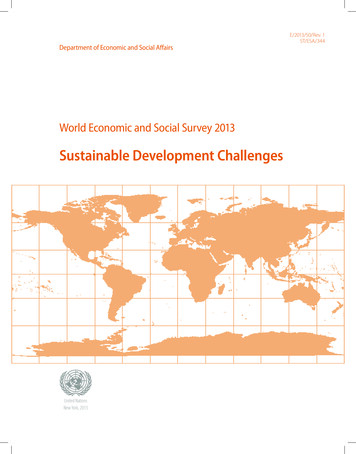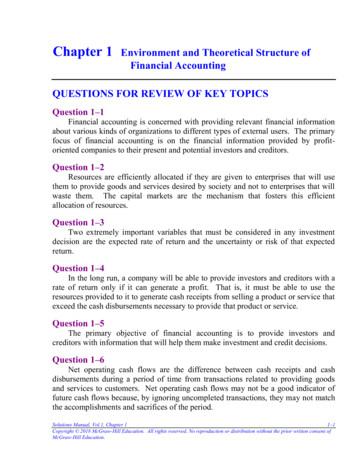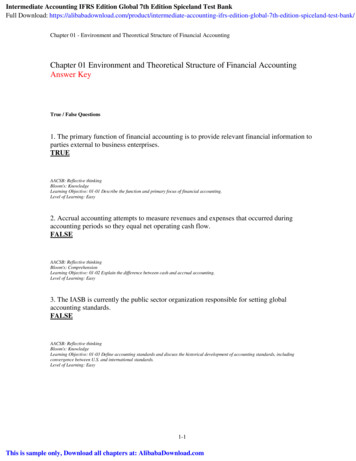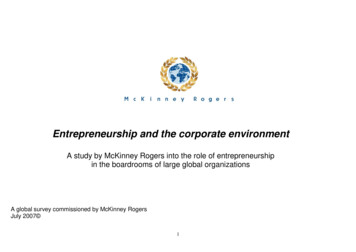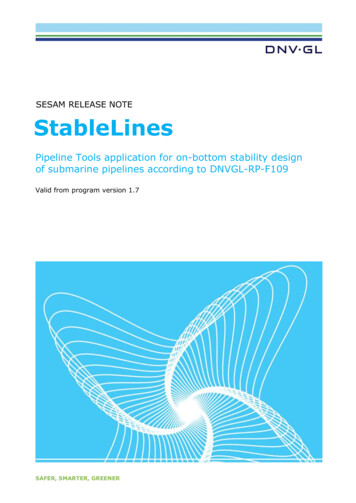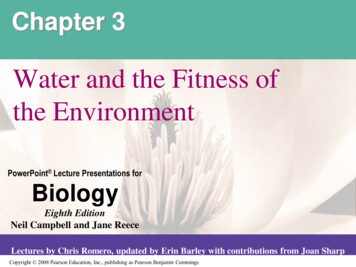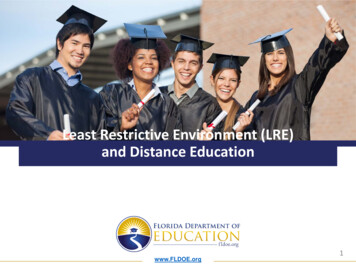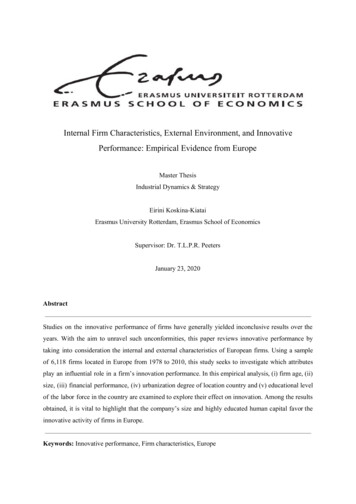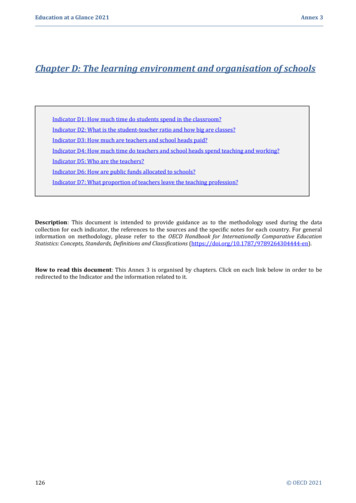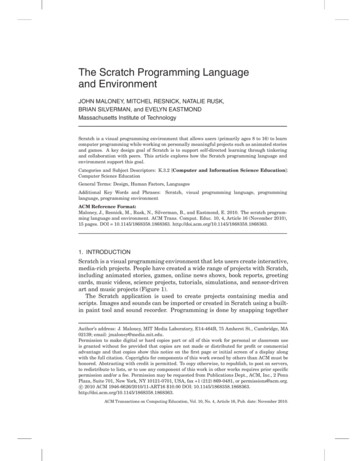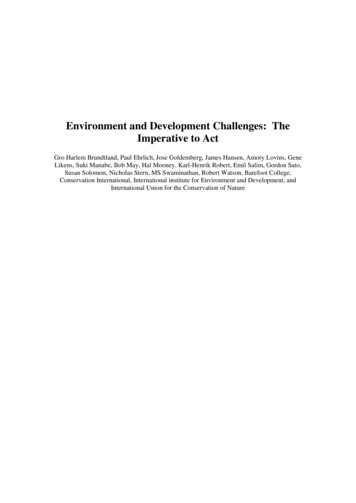
Transcription
Environment and Development Challenges: TheImperative to ActGro Harlem Brundtland, Paul Ehrlich, Jose Goldemberg, James Hansen, Amory Lovins, GeneLikens, Suki Manabe, Bob May, Hal Mooney, Karl-Henrik Robert, Emil Salim, Gordon Sato,Susan Solomon, Nicholas Stern, MS Swaminathan, Robert Watson, Barefoot College,Conservation International, International institute for Environment and Development, andInternational Union for the Conservation of Nature
Table of ContentsPART 1: Synthesis ReportPrefaceKey Messages1.0The Problem1.1Introduction1.2Underlying Drivers of 1.2.4Socio-Political1.2.5Cultural1.3Current and Projected State of the Global and Regional Environment:Implications of Climate Change and Loss of Biodiversity and EcosystemServices for Environmental, Economic and Social Sustainability1.3.1Climate Change1.3.2Biodiversity, Ecosystems and their Services1.3.3Food Security1.3.4Water Security1.3.5Human Security2.0The Way Forward2.1Our Vision2.2The Need to Act2.3Technology Options for a Transition to a Low-Carbon Economy2.4Adapting to Climate Change2.5Approaches to Conserve and Sustainably Use Biodiversity2.6Food Security2.7Water Security2.8Competence in Leadership2.9The Importance of Good Governance2.10Regional Cooperation2.11Innovation and Grass Roots Action2.12Knowledge Generation and Assessment3.0ConclusionPART 2 – Individual Contributions1. Gro Harlem Brundtland: Resilient People; Resilient Planet: A future worthchoosing;2. Paul R. Ehrlich and Anne H. Ehrlich: Our unrecognized emergency;3. José Goldemberg: The emergence of the BRICS and climate change;4. James E. Hansen Environment and Development Challenges: The Imperative of aCarbon Fee and Dividend;5. Amory B. Lovins and José Goldemberg: The global transition beyond fossil fuels;6. Gene E. Likens: The Ecosystem Approach for Understanding and ResolvingEnvironmental Problems;7. Syukuro Manabe: Global Warming and Water Resources;8. Robert May: Underlying Drivers of Change and Their Inter-relationships Demographic Changes;9. Harold Mooney: Ecosystem Services: Protecting our heritage and life supportsystem: some key issues and ways forward;2
10. Karl-Henrik Robèrt: The Policy-Science Nexus - An area for ImprovedCompetence in Leadership;11. Emil Salim: The Search of a Green Equitable Economy;12. Gordon H. Sato: Seawater based Carbon sequestration- the key to climate changemitigation and adaptation;13. Susan Solomon: Irreversibility of Climate Changes Due to Anthropogenic CarbonDioxide Increases;14. Nick Stern – Climate change, economics and a new energy-industrial revolution;15. M S Swaminathan: Rio 20 : Green Economy with Inclusive Growth;16. Robert Watson: Agriculture and Food Security;17. Robert Watson: Current and Projected State of the Global and Regional Environment:Implications for Environmental, Economic and Social Sustainability;18. Bunker Roy, Barefoot College: Innovation and Grass Root Action;19. Saleem Huq, International Institute of Environment and Development: Adapting toClimate Change;20. Camilla Toulmin, International Institute of Environment and Development: TheImportance of Good Governance;21. Will R. Turner, Russell A. Mittermeier, Julia Marton-Lefèvre, Simon N. Stuart,Jane Smart, Josephine M. Langley, Frank W. Larsen, and Elizabeth R. Selig,Conservation International and IUCN: Biodiversity: Conserving the foundation ofsustainable development;22. Will R. Turner*, Russell A. Mittermeier, Julia Marton-Lefèvre, Simon N. Stuart,Jane Smart, David G. Hole, Elizabeth R. Selig, Conservation International andIUCN: Climate change: Protecting biodiversity and harnessing nature‘s climatesolutions;23. Will R. Turner, Russell A. Mittermeier, Rachel Neugarten, Julia Marton-Lefèvre,Simon N. Stuart, Jane Smart, Conservation International and IUCN: Ecosystemservices: Accounting for the benefits that nature provides to humanity;3
PrefacePart 1 of this paper is a synthesis of the key messages from the individual papers written bythe Blue Planet Laureates (attached in Part 2), and discusses the current and projected state ofthe global and regional environment, and the implications for environmental, social andeconomic sustainability. It addresses the drivers for change, the implications for inaction, andwhat is needed to achieve economic development and growth among the poor, coupled withenvironmental and social sustainability, and the imperative of action now. The paper does notclaim to address comprehensively all environment and development issues, but a sub-set thatare deemed to be of particular importance.In 1992, the year of the Rio Earth Summit, the Asahi Glass Foundation established the BluePlanet Prize, an award presented to individuals or organizations worldwide in recognition ofoutstanding achievements in scientific research and its application that have helped providesolutions to global environmental problems. The Prize is offered in the hopes of encouragingefforts to bring about the healing of the Earth‘s fragile environment.The award‘s name was inspired by the remark "the Earth was blue," uttered by the firsthuman in space, Russian cosmonaut Yuri Gagarin, upon viewing our planet. The Blue PlanetPrize was so named in the hopes that our blue planet will be a shared asset capable of sustaininghuman life far into the future. 2012 is the 20th anniversary of the Blue Planet Prize. The AsahiGlass Foundation wishes to mark this anniversary with a fresh start in its efforts to help build anenvironmentally friendly society.4
Key MessagesWe have a dream – a world without poverty – a world that is equitable – a world thatrespects human rights – a world with increased and improved ethical behavior regardingpoverty and natural resources - a world that is environmentally, socially and economicallysustainable, where the challenges such as climate change, loss of biodiversity and socialinequity have been successfully addressed. This is an achievable dream, but the currentsystem is deeply flawed and our current pathway will not realise it.Population size and growth and related consumption patterns are critical elements in themany environmental degradation and social problems we currently face. The populationissue should be urgently addressed by education and empowerment of women, including inthe work-force and in rights, ownership and inheritance; health care of children and theelderly; and making modern contraception accessible to all.There is an urgent need to break the link between production and consumption on the onehand and environmental destruction on the other. This can allow raising material livingstandards for a period that would allow us to overcome world poverty. Indefinite materialgrowth on a planet with finite and often fragile natural resources will however, eventuallybe unsustainable. Unsustainable growth is promoted by environmentally-damagingsubsidies in areas such as energy, transportation and agriculture and should be eliminated;external environmental and social costs should be internalized; and the market and nonmarket values of ecosystem goods and services should be taken into account in decisionmaking.The immense environmental, social and economic risks arising from our current path willbe much harder to manage if we are unable to measure key aspects of the problem. Forexample, governments should recognise the serious limitations of GDP as a measure ofeconomic activity and complement it with measures of the five forms of capital: built,financial, natural, human and social capital, i.e., a measure of wealth that integrateseconomic, environmental and social dimensions. Green taxes and the elimination ofsubsidies should ensure that the natural resources needed to protect poor people areavailable rather than via subsidies that often only benefit those that are better off.The present energy system, which is heavily dependent on fossil fuels, underlies many ofthe problems we face today: exhaustion of easily accessible physical resources, security ofaccess to fuels, and degradation of health and environmental conditions. Universal accessto clean energy services is vital for the poor, and a transition to a low carbon economy willrequire rapid technological evolution in the efficiency of energy use, environmentallysound low-carbon renewable energy sources and carbon capture and storage. The longerwe wait to transition to a low carbon economy the more we are locked into a high carbonenergy system with consequent environmental damage to ecological and socio-economicsystems, including infrastructure.Emissions of GHG are one of the greatest threats to our future prosperity. World emissions(flows) are currently around 50 billion tonnes of carbon dioxide-equivalent (CO2e) perannum and are growing rapidly. As the terrestrial and oceanic ecosystems are unable toabsorb all of the world‘s annual emissions, concentrations (stocks) of GHG emissions inthe atmosphere have increased, to over 400ppm of CO2e today (even after taking theoffsetting radiative effects of aerosols into account) and increasing at a rate of around2.5ppm per year. Thus we have a flow-stock problem. Without strong action to reduceemissions, over the course of this century we would likely add at least 300 ppm CO2e,taking concentrations to around 750 ppm CO2e or higher at the end of the century or earlyin the next. The world‘s current commitments to reduce emissions are consistent with atleast a 3oC rise (50-50 chance) in temperature: a temperature not seen on the planet foraround 3 million years, with serious risks of 5oC rise: a temperature not seen on the planetfor around 30 million years. Given there are some uncertainties present in all steps of thescientific chain (flows to stocks to temperatures to climate change and impacts), this is aproblem of risk management and public action on a great scale.5
Biodiversity has essential social, economic, cultural, spiritual and scientific values and itsprotection is hugely important for human survival. The rapid loss of biodiversity,unprecedented in the last 65 million years, is jeopardising the provision of ecosystemservices that underpin human well-being. The Millennium Ecosystem Assessmentconcluded that 15 of the 24 ecosystem services evaluated were in decline, 4 wereimproving, and 5 were improving in some regions of the world and in decline in otherregions. Measures to conserve biodiversity and make a sustainable society possible need tobe greatly enhanced and integrated with social, political and economic concerns. There is aneed to value biodiversity and ecosystem services and create markets that can appropriatethe value for these services as a basis for a ‗green‘ economy.There are serious short-comings in the decision making systems at local, national andglobal levels on which we rely in government, business and society. The rules andinstitutions for decision making are influenced by vested interests, with each interesthaving very different access to how decisions are made. Effective change in governancedemands action at many levels to establish transparent means for holding those in power toaccount. At the local level public hearings and social audits can bring the voices ofmarginalized groups into the forefront. At a national level, parliamentary and pressoversight are key. Globally, we must find better means to agree and implement measures toachieve collective goals. Governance failures also occur because decisions are being madein sectoral compartments, with environmental, social and economic dimensions addressedby separate, competing structures.Decision makers should learn from ongoing grass-roots actions and knowledge in areassuch as energy, food, water, natural resources, finance and governance. This is key, not theleast in rural communities with a view to their management, control and ownership of theseresources. There is a need to scale-up the grass roots actions by bringing together acomplementary top-down and bottom-up approach to addressing these issues. Globalcooperation can be improved by building on on-going regional cooperation to deal withcommon sustainable development issues.Effective training programs should be implemented to multiply the number of competentdecision makers in business and government. They must learn how to integrateprogrammes and policies within sustainability constraints, to understand the business casethereof, and acquire the skills to strategically move towards such sustainability goals.All of the problems mentioned above demand we increase investments in education,research and assessments of knowledge. The goal of education for all must be realized.The Future Earth Program that is currently under development by ICSU and ISSC willprovide the multi-disciplinary knowledge base (social science, humanities,economics, natural sciences, engineering and technologies) needed for sustainabledevelopment. Future Earth needs to be complemented by a web-based multi-disciplinary knowledge assessment system, which critically reviews, integrates and synthesizes newknowledge with previous information in as close to real time as possible to strengthen thescience-policy interface.If we are to achieve our dream, the time to act is now, given the inertia in the socioeconomic system, and that the adverse effects of climate change and loss of biodiversitycannot be reversed for centuries or are irreversible (for example, species loss). We knowenough to act, but the current scientific uncertainties, means that we are facing a problemof risk management on an immense scale. Failure to act will impoverish current and futuregenerations.6
1.0The Problem1.1IntroductionWe have a dream – a world without poverty – a world that is equitable – a world thatrespects human rights – a world with increased and improved ethical behavior regarding povertyand natural resources - a world that is environmentally, socially and economically sustainable,and where economic growth is accom
2.3 Technology Options for a Transition to a Low-Carbon Economy 2.4 Adapting to Climate Change 2.5 Approaches to Conserve and Sustainably Use Biodiversity 2.6 Food Security 2.7 Water Security 2.8 Competence in Leadership 2.9 The Importance of Good Governance 2.10 Regional Cooperation 2.11 Innovation and Grass Roots Action 2.12 Knowledge Generation and Assessment 3.0 Conclusion
